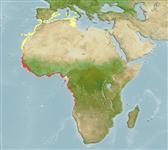Environment: milieu / climate zone / depth range / distribution range
Ecology
Marine; brackish; demersal; depth range 10 - 100 m (Ref. 10001). Subtropical; 44°N - 13°S, 18°W - 14°E (Ref. 128784)
Eastern Atlantic: Gibraltar and extreme western Mediterranean southward along the entire west coast of Africa to Angola, near Benguela.
Size / Weight / Age
Maturity: Lm ? range ? - ? cm
Max length : 80.0 cm TL male/unsexed; (Ref. 7059); common length : 55.0 cm TL male/unsexed; (Ref. 2683); max. published weight: 4.3 kg (Ref. 4699)
Common in shallow coastal waters, also in estuaries (Ref. 2683), bays and lagoons, as well as in offshore trawling stations. Feeds on crabs, echinoids and mollusks (Ref. 10001). Occurs over hard substrate (Ref. 5377).
Life cycle and mating behavior
Maturity | Reproduction | Spawning | Eggs | Fecundity | Larvae
Shipp, R.L., 1990. Tetraodontidae. p. 1069-1072. In J.C. Quero, J.C. Hureau, C. Karrer, A. Post and L. Saldanha (eds.) Check-list of the fishes of the eastern tropical Atlantic (CLOFETA). JNICT, Lisbon; SEI, Paris; and UNESCO, Paris. Vol. 2. (Ref. 7464)
IUCN Red List Status (Ref. 130435: Version 2024-2)
Threat to humans
Harmless
Human uses
Fisheries: commercial; gamefish: yes
Tools
Special reports
Download XML
Internet sources
Estimates based on models
Preferred temperature (Ref.
123201): 19.2 - 27.9, mean 25.7 °C (based on 86 cells).
Phylogenetic diversity index (Ref.
82804): PD
50 = 1.0000 [Uniqueness, from 0.5 = low to 2.0 = high].
Bayesian length-weight: a=0.01622 (0.00726 - 0.03621), b=2.92 (2.74 - 3.10), in cm total length, based on LWR estimates for this (Sub)family-body shape (Ref.
93245).
Trophic level (Ref.
69278): 3.6 ±0.53 se; based on food items.
Resilience (Ref.
120179): Medium, minimum population doubling time 1.4 - 4.4 years (Preliminary K or Fecundity.).
Fishing Vulnerability (Ref.
59153): Moderate to high vulnerability (52 of 100).
Nutrients (Ref.
124155): Calcium = 51.9 [17.6, 122.7] mg/100g; Iron = 0.96 [0.54, 1.98] mg/100g; Protein = 19.1 [17.0, 21.3] %; Omega3 = 0.374 [0.175, 0.735] g/100g; Selenium = 30.7 [16.8, 64.2] μg/100g; VitaminA = 8.44 [3.70, 19.02] μg/100g; Zinc = 0.725 [0.529, 1.009] mg/100g (wet weight);
